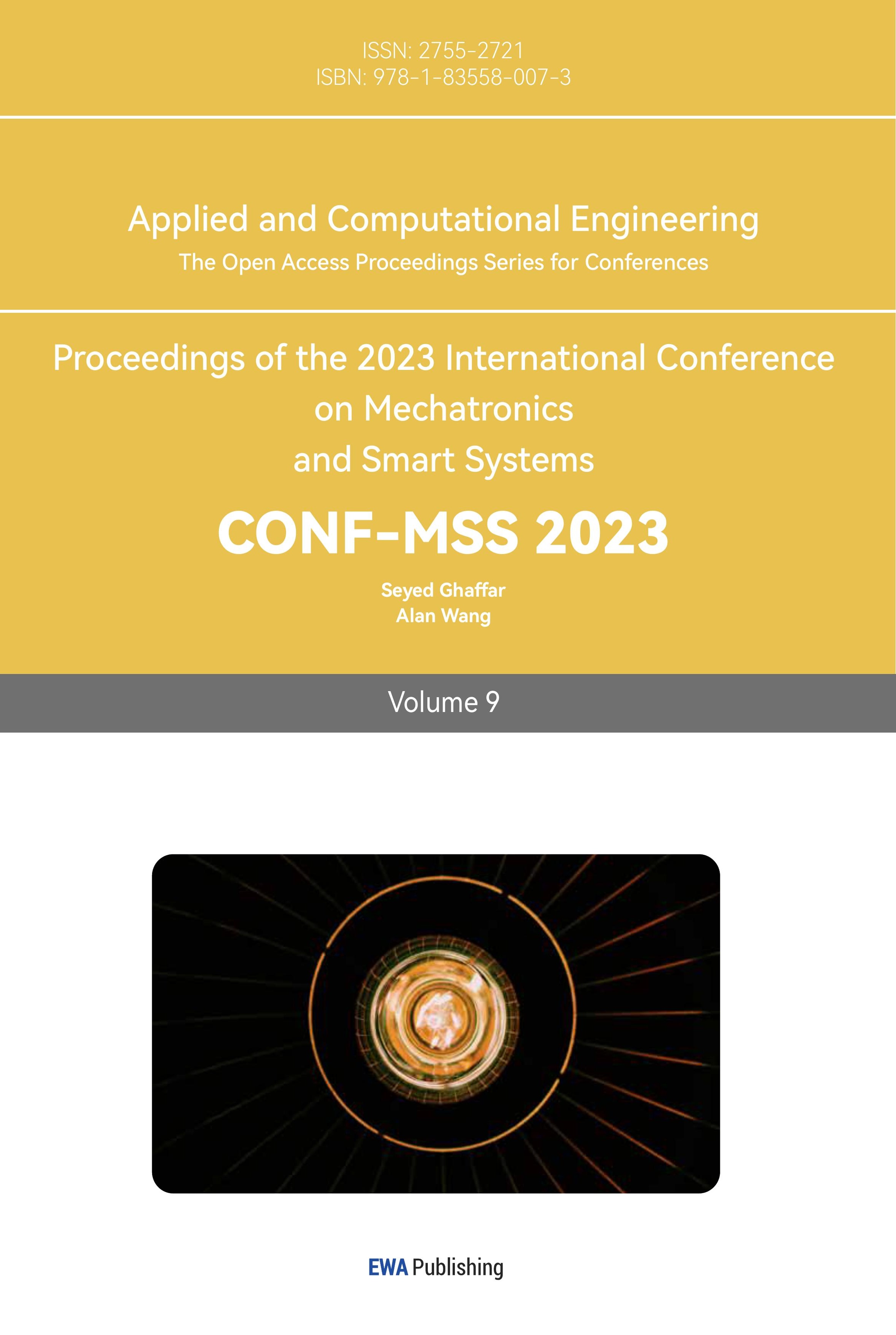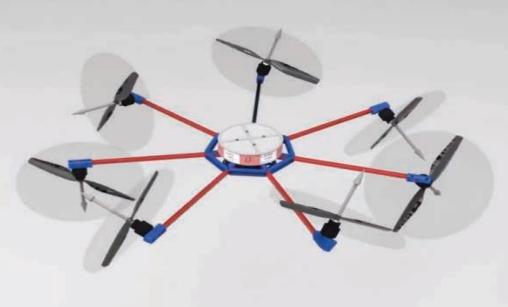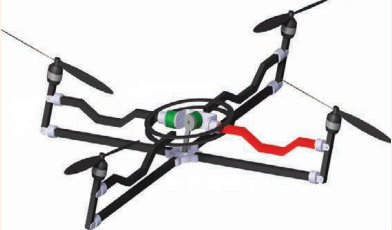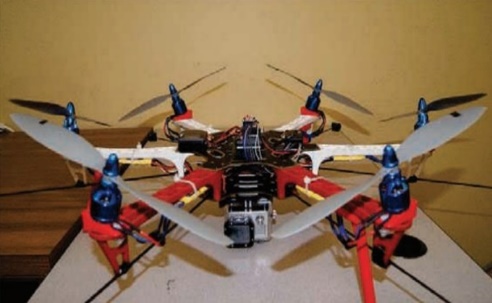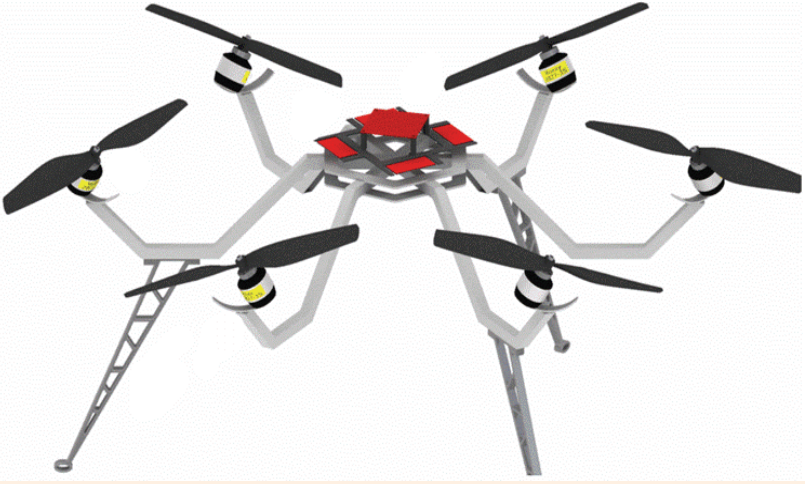1. Introduction
Unmanned aerial vehicles (UAVs) is a special type of aircraft without depending on pilot driving, which is now widely used in many fields. Originally the UAVs were invented for high-risks military missions, including infiltration, reconnaissance, and precise destruction. But with technology development in 21st century, lower cost and reduced design difficulty make the UAVs gradually applied in the civilian field [1].
In terms of information collection, UAVs supply effective and ideal solution in meteorology, search and rescue, exploration, and mapping. In terms of economize on manpower, UAVs could take the responsibility of pesticide spraying, delivery, and firefighting [2-4]. The unmanned property give UAVs great flexibility compared to manned craft. With the integration of more sensors and the compact body, the functionality and potential of UAVs are increased, which establishes it as an important position in various professional fields.
Generally, UAVs can be divided into two large categories: rotor wing and fixed wing. Fixed-wing UAVs have the characteristics of high speed and high energy consumption, which will not be explored due to its efficient but complex aerodynamics layout [5]. Nowadays, civilian multi-rotor UAVs are developing rapidly. The rotors in the same plane supply stable and adjustable lift force to complete functions such as take-off, hover, pan and turn. Civilian market favours it precisely for its mechanical simplicity and relative ease of operation. If more detailed division, multi-rotor UAVs can be classified by the number of rotors, like the quadcopter UAV commonly seen in mainstream market or the hexadecopter UAV with higher stability [2].
Talking about actuated control, the UAVs industry adopts several feedback control methods to reduce error and track the target state. As for the multi-rotor UAVs, the four-rotor and six-rotor have different feedback control methods due to their different dynamic structures. Proper flight control methods can help drones control attitude and altitude, thus achieving better performance. However, conventional multi-rotor UAVs have its disadvantages. The unactuated dynamics generated by unwanted coupling between the horizontal and rotational dynamics cause that drone need to tilt the fuselage first and then lift for translation, which reduces flexibility to some extent. Therefore, in recent years, fully actuated multi-rotor UAVs are developed with inclined rotors, which bring lift in the inclined direction. More freedom degrees due to tilting force increase flexibility, equipping drones the ability to maneuver in smaller space and in shorter time. The installation of inclined rotors brings not only more possibilities, but also more challenges. The change of the original aerodynamic layout requires a new structure design and modelling. The increase of variable also needs the improvement of feedback control methods.
In this article, the above two points will be studied separately to verify the feasibility of fully actuated multi-rotor UAV. First, the structure design and model construction of fully actuated multi-rotor UAV are discussed and analyzed. Then, the types of fully actuated multi-rotor are classified and analyzed in combination with relevant papers in recent years. Then, the feedback control method is analyzed on the basis of mathematical modeling. Finally, the full text is summarized and prospected.
2. Structure design and modelling
In this section, fully actuated UAVs will be analyzed from the perspective of rotor mounting type, transfer matrix, full actuated architecture classification.
1.1 Rotor mounting type
Nowadays there are two main tilt-rotor installation ways to achieve full actuation. One is applying fixed propellers with different tilting angles, another is applying moveable propellers can rotate within a certain range. Here these two concepts are referred as fixed-tilt and variable-tilt [2], As shown in Figure 1 and Figure 2.
|
|
Figure 1. Fixed-tilt multi-rotor UAV [6]. | Figure 2. Variable-tilt multi-rotor UAV [7]. |
1.2 Modelling
The addition of inclined rotor changes the original transmission layout of UAV and complicates it. Based on the principle of dynamic vector form rotor to fuselage, the extra degrees of freedom will change the control allocation matrix. Models of UAV with different rotor allocation modes can be established by the following expression.
\( W_{c}^{B}=Mλ \) (1)
Where \( λ={({λ_{1}},…,{λ_{{N_{p}}}})^{T}} ∈ Λ \) is the rotor’s thrust vector and \( M∈ {R^{6*{N_{p}}}} \) is the control allocation matrix. As shown in Eq. (1), the mapping matrix \( M \) is defined in order to match the allowable propeller-thrust space \( Λ \) to the allowable aerodynamic-control wrench space \( W \) . For fixed-tilt UAVs, \( M \) is a constant matrix, but for variable-tilt UAVs, it is a function of angles related to extra rotors [8]. Thus, in mathematical modelling, models of UAV with different rotor allocation modes can be established by virtue of the master of Eq. (1).
1.3 Classification
Compared to underactuated concepts, the difference on assembly of fully actuated tilting rotor leads to wide range of possible configurations. Therefore, it is necessary to classify the full actuation types. Table attached below to be detailed.
Table 1. Full actuation classification | |
Inclination setting | Definition |
Fixed-Tilt | Quadrotor with four horizontal rotors (Quad4Hor) |
Hexarotor with canted rotors (HexC) | |
Hexarotor with canted and dihedral rotors (HexCD) | |
Coaxial hexagon with 12 canted rotors (CoHexC) | |
Double tetrahedron hexarotor (HexDTet) | |
Heptarotor with minimized frame (HeptF) | |
Heptarotor with maximized wrench (HeptW) | |
Octarotor cube (OctCu) | |
Octarotor beam (OctB) | |
Variable-Tilt | Quadrotor with variable cant rotors (QuadvC) |
Quadrotor with variable dihedral rotors (QuadvD) | |
Quadrotor with variable cant and dihedral rotors (QuadvCD) | |
Quadrotor with coupled variable cant and dihedral rotors (QuadvCDc) | |
Hexarotor with variable cant rotors (HexvC) | |
Hexarotor with coupled variable cant rotors (HexvCc) | |
It can be seen from literature survey that the HexC and HexCD concept have been extensively studied in recent years, which is due to their mechanical simplicity and less workload of transforming from conventional hexarotor to full actuation structure, as shown in Figure 3 and Figure 4 [2]. Moreover, the HexC structure got better performance on disturbance-rejection against lateral wind gusts compared with conventional hexarotor [9]. The concept of omnidirectional versions have been proposed and developed, the aim of which is to optimize the wrench to achieve the optimal solution of dynamic conversion [10,11].
|
|
Figure 3. HexC structure [12]. | Figure 4. HexCD structure [13]. |
3. Feedback control method
In the practical application of UAV, the design of flight model needs to be equipped with feedback control system, to achieve the tracking of expected attitude, hover, throttle condition. Taking the drone as the control object, the speed of each motor is the control input and the flight state is the control output. On the basis of mathematical modelling, the setting and adjustment of parameters between them will directly affect the attitude adjustment and error correction capability of UAV in actual flight.
When it comes to fully actuated UAVs, traditional controllers such as PID control will not be effective in providing stable state tracking due to extra tilting dynamic vector of inclined rotors. Although PID control method has an important position in UAV control field due to its simple and efficient properties, it’s not good at handling complex structures with too many variables and disturbance-rejection problem especially under the condition of nonlinear mathematical models of variable-tilt full actuation. Thus new feedback control methods need to be developed to solve and improve fully actuated UAVs control. Many experts and scholars have proposed many novel methods. For example, a kind of robust adaptive control method on fully actuated octocopter UAV was proposed to handle effect of parametric uncertainties and external disturbance in [9]. A robust pose tracking control method for a fully actuated hexarotor UAV based on Gaussian process was developed to tack position and attitude of drone in [14].
4. Conclusion
This article proves that both the design and control of fully driven UAVs are feasible enough. Through the above demonstration, its higher possibility can be proved to have better performance in urban traffic management, debris search and rescue, geological exploration and other conditions that demand work in extreme environments. Moreover, fully actuated multi-rotor UAVs are still in the development phase, it requires industry norms in structural design and a general approach to feedback control. The author believes it has a broader future and rapid progress.
References
[1]. Kanellakis, Christoforos, and George Nikolakopoulos. “Survey on Computer Vision for UAVs: Current Developments and Trends.” Journal of intelligent & robotic systems 87.1 (2017): 141–168. Web.
[2]. Rashad, Ramy et al. “Fully Actuated Multirotor UAVs: A Literature Review.” IEEE robotics & a-utomation magazine 27.3 (2020): 97–107.
[3]. Butilă, Eugen Valentin, and Răzvan Gabriel Boboc. “Urban Traffic Monitoring and Analysis Usi-ng Unmanned Aerial Vehicles (UAVs): A Systematic Literature Review.” Remote sensing (B-asel, Switzerland) 14.3 (2022): 620.
[4]. Garnica-Peña, Ricardo J., and Irasema Alcántara-Ayala. “The Use of UAVs for Landslide Disast-er Risk Research and Disaster Risk Management: a Literature Review.” Journal of mountain science 18.2 (2021): 482–498.
[5]. R. Austin, Unmanned Aircraft Systems: UAVS Design, Development and Deployment. Hoboke-n, NJ: Wiley, 2010.
[6]. Tognon, Marco, and Antonio Franchi. “Omnidirectional Aerial Vehicles With Unidirectional Thr-usters: Theory, Optimal Design, and Control.” IEEE robotics and automation letters 3.3 (2018): 2277–2282. Web.
[7]. M. Odelga, P. Stegagno and H. H. Bülthoff, "A fully actuated quadrotor UAV with a propeller til-ting mechanism: Modeling and control," 2016 IEEE International Conference on Advanced Intelligent Mechatronics (AIM), Banff, AB, Canada, 2016, pp. 306-311, doi: 10.1109/AIM.2016.7576784.
[8]. S. Stramigioli, Modeling and IPC Control of Interactive Mechanical System—A Coordinate-Fre-e Approach. London: Springer-Verlag, 2001.
[9]. P. Roque and R. Ventura, “Space CoBot: Modular design of a holonomic aerial robot for indoor microgravity environments,” in Proc. 2016 IEEE/RSJ Int. Conf. Intelligent Robots and Systems (IROS), pp. 4383–4390.
[10]. E. Kaufman, K. Caldwell, D. Lee, and T. Lee, “Design and development of a free-floating hexro-tor UAV for 6-DoF maneuvers,” in Proc. 2014 IEEE Aerospace Conf.
[11]. Shu, Panfeng et al. “Robust Adaptive Control for A Novel Fully-Actuated Octocopter UAV with Wind Disturbance.” Journal of intelligent & robotic systems 103.1 (2021): n. pag.
[12]. Guangying Jiang, and Richard Voyles. “Hexrotor UAV Platform Enabling Dextrous Interaction with Structures-Flight Test.” 2013 IEEE International Symposium on Safety, Security, and Re-scue Robotics (SSRR). IEEE, 2013. 1–6. Web.
[13]. S. Rajappa, M. Ryll, H. H. Bülthoff and A. Franchi, "Modeling, control and design optimization for a fully-actuated hexarotor aerial vehicle with tilted propellers," 2015 IEEE International C-onference on Robotics and Automation (ICRA), Seattle, WA, USA, 2015, pp. 4006-4013, do-i: 10.1109/ICRA.2015.7139759.
[14]. Ibuki, Tatsuya, Hiroto Yoshioka, and Mitsuji Sampei. “Robust Pose Tracking Control for a Fully-Actuated Hexarotor UAV Based on Gaussian Processes.” SICE journal of control, measurem-ent, and system integration 15.2 (2022): 201–210.
Cite this article
Hu,Z. (2023). Feasibility study and development analysis of fully actuated multi-rotor UAVs. Applied and Computational Engineering,9,22-26.
Data availability
The datasets used and/or analyzed during the current study will be available from the authors upon reasonable request.
Disclaimer/Publisher's Note
The statements, opinions and data contained in all publications are solely those of the individual author(s) and contributor(s) and not of EWA Publishing and/or the editor(s). EWA Publishing and/or the editor(s) disclaim responsibility for any injury to people or property resulting from any ideas, methods, instructions or products referred to in the content.
About volume
Volume title: Proceedings of the 2023 International Conference on Mechatronics and Smart Systems
© 2024 by the author(s). Licensee EWA Publishing, Oxford, UK. This article is an open access article distributed under the terms and
conditions of the Creative Commons Attribution (CC BY) license. Authors who
publish this series agree to the following terms:
1. Authors retain copyright and grant the series right of first publication with the work simultaneously licensed under a Creative Commons
Attribution License that allows others to share the work with an acknowledgment of the work's authorship and initial publication in this
series.
2. Authors are able to enter into separate, additional contractual arrangements for the non-exclusive distribution of the series's published
version of the work (e.g., post it to an institutional repository or publish it in a book), with an acknowledgment of its initial
publication in this series.
3. Authors are permitted and encouraged to post their work online (e.g., in institutional repositories or on their website) prior to and
during the submission process, as it can lead to productive exchanges, as well as earlier and greater citation of published work (See
Open access policy for details).
References
[1]. Kanellakis, Christoforos, and George Nikolakopoulos. “Survey on Computer Vision for UAVs: Current Developments and Trends.” Journal of intelligent & robotic systems 87.1 (2017): 141–168. Web.
[2]. Rashad, Ramy et al. “Fully Actuated Multirotor UAVs: A Literature Review.” IEEE robotics & a-utomation magazine 27.3 (2020): 97–107.
[3]. Butilă, Eugen Valentin, and Răzvan Gabriel Boboc. “Urban Traffic Monitoring and Analysis Usi-ng Unmanned Aerial Vehicles (UAVs): A Systematic Literature Review.” Remote sensing (B-asel, Switzerland) 14.3 (2022): 620.
[4]. Garnica-Peña, Ricardo J., and Irasema Alcántara-Ayala. “The Use of UAVs for Landslide Disast-er Risk Research and Disaster Risk Management: a Literature Review.” Journal of mountain science 18.2 (2021): 482–498.
[5]. R. Austin, Unmanned Aircraft Systems: UAVS Design, Development and Deployment. Hoboke-n, NJ: Wiley, 2010.
[6]. Tognon, Marco, and Antonio Franchi. “Omnidirectional Aerial Vehicles With Unidirectional Thr-usters: Theory, Optimal Design, and Control.” IEEE robotics and automation letters 3.3 (2018): 2277–2282. Web.
[7]. M. Odelga, P. Stegagno and H. H. Bülthoff, "A fully actuated quadrotor UAV with a propeller til-ting mechanism: Modeling and control," 2016 IEEE International Conference on Advanced Intelligent Mechatronics (AIM), Banff, AB, Canada, 2016, pp. 306-311, doi: 10.1109/AIM.2016.7576784.
[8]. S. Stramigioli, Modeling and IPC Control of Interactive Mechanical System—A Coordinate-Fre-e Approach. London: Springer-Verlag, 2001.
[9]. P. Roque and R. Ventura, “Space CoBot: Modular design of a holonomic aerial robot for indoor microgravity environments,” in Proc. 2016 IEEE/RSJ Int. Conf. Intelligent Robots and Systems (IROS), pp. 4383–4390.
[10]. E. Kaufman, K. Caldwell, D. Lee, and T. Lee, “Design and development of a free-floating hexro-tor UAV for 6-DoF maneuvers,” in Proc. 2014 IEEE Aerospace Conf.
[11]. Shu, Panfeng et al. “Robust Adaptive Control for A Novel Fully-Actuated Octocopter UAV with Wind Disturbance.” Journal of intelligent & robotic systems 103.1 (2021): n. pag.
[12]. Guangying Jiang, and Richard Voyles. “Hexrotor UAV Platform Enabling Dextrous Interaction with Structures-Flight Test.” 2013 IEEE International Symposium on Safety, Security, and Re-scue Robotics (SSRR). IEEE, 2013. 1–6. Web.
[13]. S. Rajappa, M. Ryll, H. H. Bülthoff and A. Franchi, "Modeling, control and design optimization for a fully-actuated hexarotor aerial vehicle with tilted propellers," 2015 IEEE International C-onference on Robotics and Automation (ICRA), Seattle, WA, USA, 2015, pp. 4006-4013, do-i: 10.1109/ICRA.2015.7139759.
[14]. Ibuki, Tatsuya, Hiroto Yoshioka, and Mitsuji Sampei. “Robust Pose Tracking Control for a Fully-Actuated Hexarotor UAV Based on Gaussian Processes.” SICE journal of control, measurem-ent, and system integration 15.2 (2022): 201–210.





